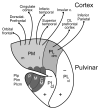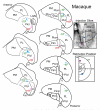Pulvinar contributions to the dorsal and ventral streams of visual processing in primates
- PMID: 17433837
- PMCID: PMC2100380
- DOI: 10.1016/j.brainresrev.2007.02.008
Pulvinar contributions to the dorsal and ventral streams of visual processing in primates
Abstract
The visual pulvinar is part of the dorsal thalamus, and in primates it is especially well developed. Recently, our understanding of how the visual pulvinar is subdivided into nuclei has greatly improved as a number of histological procedures have revealed marked architectonic differences within the pulvinar complex. At the same time, there have been unparalleled advances in understanding of how visual cortex of primates is subdivided into areas and how these areas interconnect. In addition, considerable evidence supports the view that the hierarchy of interconnected visual areas is divided into two major processing streams, a ventral stream for object vision and a dorsal stream for visually guided actions. In this review, we present evidence that a subset of medial nuclei in the inferior pulvinar function predominantly as a subcortical component of the dorsal stream while the most lateral nucleus of the inferior pulvinar and the adjoining ventrolateral nucleus of the lateral pulvinar are more devoted to the ventral stream of cortical processing. These nuclei provide cortico-pulvinar-cortical interactions that spread information across areas within streams, as well as information relayed from the superior colliculus via inferior pulvinar nuclei to largely dorsal stream areas.
Figures










References
-
- Adams AD, Hof PR, Gattass R, Webster MJ, Ungerleider LG. Visual cortical projections and chemoarchitecture of macaque monkey pulvinar. J. Comp. Neurol. 2000;419:377–393. - PubMed
-
- Allman JM, Kaas JH. A representation of a visual field in the caudal third of the middle temporal gyrus of the owl monkey (Aotus trivirgatus) Brain Res. 1971;31:85–105. - PubMed
-
- Allman JM, Kaas JH. A crescent-shaped cortical visual area surrounding the middle temporal area (MT) in the owl monkey (Aotus trivirgatus) Brain Res. 1974;81:199–213. - PubMed
-
- Allman JM, Kaas JH. The dorsomedial cortical visual area: A third tier area in the occipital lobe of the owl monkey (Aotus trivirgatus) Brain Res. 1975;100:473–487. - PubMed
-
- Baizer JS, Desimone R, Ungerleider LG. Comparison of subcortical connections of inferior temporal and posterior parietal cortex in monkeys. Vis. Neurosci. 1993;10:59–72. - PubMed
Publication types
MeSH terms
Grants and funding
LinkOut - more resources
Full Text Sources

